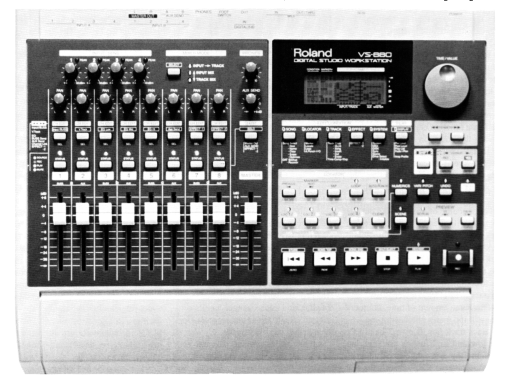
by Jerry Vigil
Digital audio workstations are evolving quickly. The combination of more players in the game and rapidly advancing technology is producing workstations loaded with features at prices unthinkable just a few years ago. It's a wonderful life. Roland's new VS-880 Digital Studio Workstation is turning a lot of heads, and it's no wonder. This is an 8-track digital workstation with a built-in digital mixer for a mere $2,595. Keep that figure in mind as you read this review.
The VS-880 is about 17 inches wide, 12 inches deep, and 3 1/2 inches high. It takes up about as much desktop space as a typewriter, and that's all there is to it--no monitor, no keyboard, no mouse, no rack-mount hardware.
The rear panel offers two sets of four unbalanced analog inputs, RCA and 1/4-inch. (When the 1/4-inch jacks are used, the RCA inputs are disabled.) There are four analog outputs (unbalanced RCA), the Master L/R outs and two Auxiliary Sends. Coaxial connectors provide S/PDIF digital I/O. The stereo digital input can be used together with the four analog inputs for a total of six inputs, but for radio production, you'll likely use only two inputs at a time, analog or digital, depending upon the source audio. The digital output matches the signal at the Master L/R output. A headphone jack also outputs the same signal as the Master L/R. MIDI IN and OUT/THRU jacks enable automated mixing, remote control of system parameters and more. A footswitch jack is provided for transport control and punch-in/out operation. A SCSI connector lets you connect of up to seven external drives. The AC connector and Power On/Off button complete the rear panel.
The mixer section takes up the left half of the top panel. Transport controls, editing buttons, the LCD display and other controls occupy the right half. At the top left are four INPUT SENSitivity controls with accompanying PEAK LED indicators. Analog input levels are adjustable from -50dBm to +4dBm. Each of the eight channels has its own PAN control, Channel EDIT/SEL button, STATUS button, and fader. Pressing the STATUS button switches between the four track modes: Record, Source (for monitoring the input), Play, and Mute. An LED above each button indicates the mode: red for Record, orange for Source, green for Play, and off for Mute.
The Channel EDIT/SEL buttons are used to select tracks for editing. Various editing parameters are quickly accessed by pressing a track's EDIT/SEL button with the SHIFT button. Each EDIT/SEL button is dedicated to a different set of parameters which are indicated on the panel above each button. For example, to quickly enter the Auxiliary Send parameters, press SHIFT and the EDIT/SEL button for track 6. Then press the EDIT/SEL button for the track you wish to adjust the Auxiliary Send for. A MASTER fader controls the stereo mix level. The EDIT/SOLO button activates the mixer's solo mode and accesses the mixer's global parameters. The MIXER MODE SELECT button enables advanced mixing capabilities (more on this later). The HEADPHONE and AUX SEND level controls complete the controls on the mixer section of the top panel.
The TIME/VALUE wheel at the top right of the top panel is used to adjust parameter values and for scrubbing audio. To the left is the small LCD display. The display measures 3 inches wide and 1 inch high. Yes, this is a very small display, and it takes some getting used to. But once you get familiar with the various screens, it's a lot easier to work with. The transport controls are at the bottom. You get the usual REW, FF, STOP, PLAY, REC and ZERO return. There's no playback during fast-forward and rewind. You must watch the time counter on the display or watch the graphic Playlist display to see where you're going. Single presses of the FF and REW buttons move in one-second increments. Holding the buttons down moves through the project at high speed. Between the display and the transport controls are 28 buttons that access the majority of the VS-880's powerful features.

